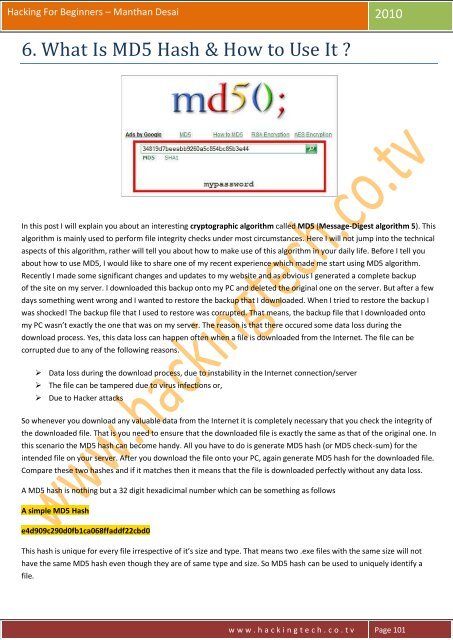Legal Disclaimer
Hacking-For-Beginners-a-beginners-guide-for-learning-ethical-hacking
Hacking-For-Beginners-a-beginners-guide-for-learning-ethical-hacking
- No tags were found...
Create successful ePaper yourself
Turn your PDF publications into a flip-book with our unique Google optimized e-Paper software.
Hacking For Beginners – Manthan Desai 2010<br />
6. What Is MD5 Hash & How to Use It ?<br />
In this post I will explain you about an interesting cryptographic algorithm called MD5 (Message-Digest algorithm 5). This<br />
algorithm is mainly used to perform file integrity checks under most circumstances. Here I will not jump into the technical<br />
aspects of this algorithm, rather will tell you about how to make use of this algorithm in your daily life. Before I tell you<br />
about how to use MD5, I would like to share one of my recent experience which made me start using MD5 algorithm.<br />
Recently I made some significant changes and updates to my website and as obvious I generated a complete backup<br />
of the site on my server. I downloaded this backup onto my PC and deleted the original one on the server. But after a few<br />
days something went wrong and I wanted to restore the backup that I downloaded. When I tried to restore the backup I<br />
was shocked! The backup file that I used to restore was corrupted. That means, the backup file that I downloaded onto<br />
my PC wasn’t exactly the one that was on my server. The reason is that there occured some data loss during the<br />
download process. Yes, this data loss can happen often when a file is downloaded from the Internet. The file can be<br />
corrupted due to any of the following reasons.<br />
‣ Data loss during the download process, due to instability in the Internet connection/server<br />
‣ The file can be tampered due to virus infections or,<br />
‣ Due to Hacker attacks<br />
So whenever you download any valuable data from the Internet it is completely necessary that you check the integrity of<br />
the downloaded file. That is you need to ensure that the downloaded file is exactly the same as that of the original one. In<br />
this scenario the MD5 hash can become handy. All you have to do is generate MD5 hash (or MD5 check-sum) for the<br />
intended file on your server. After you download the file onto your PC, again generate MD5 hash for the downloaded file.<br />
Compare these two hashes and if it matches then it means that the file is downloaded perfectly without any data loss.<br />
A MD5 hash is nothing but a 32 digit hexadicimal number which can be something as follows<br />
A simple MD5 Hash<br />
e4d909c290d0fb1ca068ffaddf22cbd0<br />
This hash is unique for every file irrespective of it’s size and type. That means two .exe files with the same size will not<br />
have the same MD5 hash even though they are of same type and size. So MD5 hash can be used to uniquely identify a<br />
file.<br />
w w w . h a c k i n g t e c h . c o . t v Page 101



